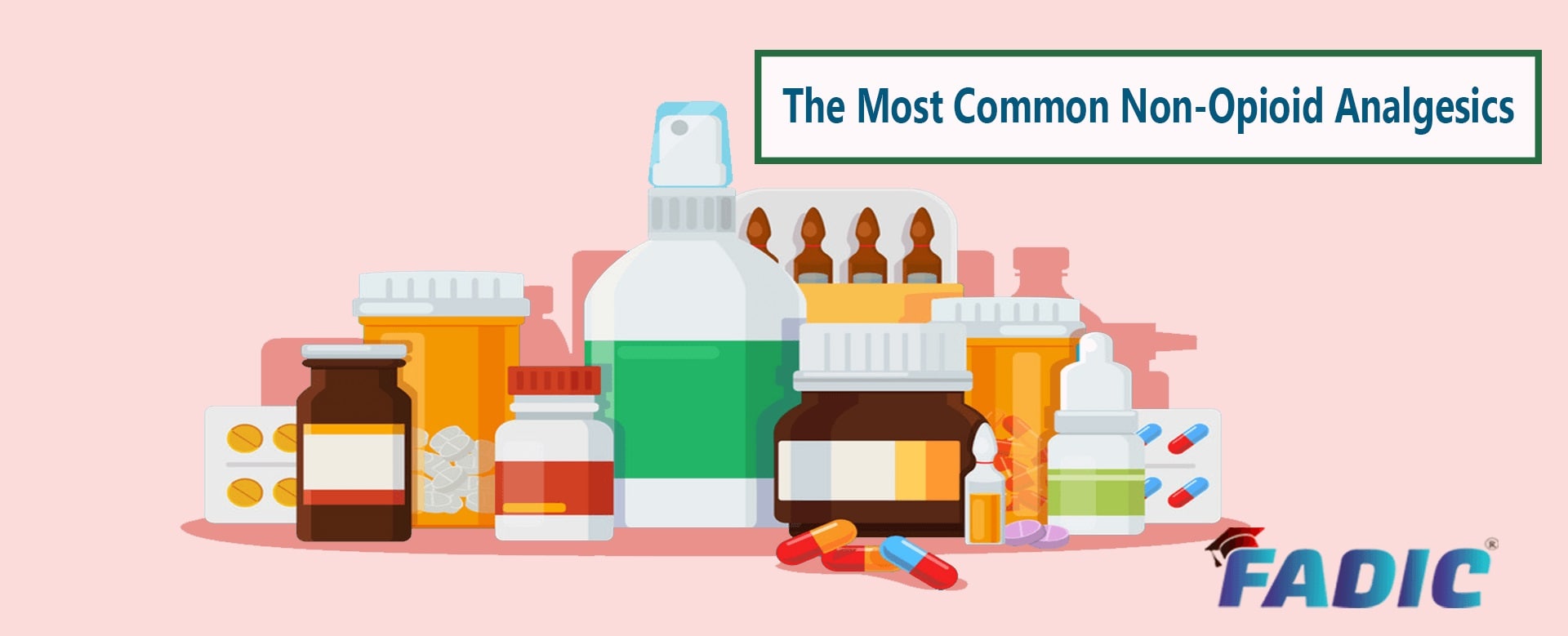Non-opioid Drugs Commonly Used for Pain Management
Non-opioid Drugs Commonly Used for Pain Management

The Most Famous Drugs Most Commonly used as Non-opioid Analgesic for Pain Management are:

Acetaminophen for Pain Management

Acetaminophen Oral : Uses, Side Effects, Dose Adjustments
- Brand Names: Cetafen
- Therapeutic Category: Analgesic, Nonopioid
- Dosage Forms: Oral (Tablet, capsule, solution, suspension, syrup), rectal suppository, solution injection
- Use: Labeled Indications:
- Injection: Management of mild to moderate pain in patients ≥2 years of age/ Temporary reduction of fever
- Off-Label: Prevention of febrile seizure with diphtheria and tetanus toxoids and acellular pertussis (DTaP) vaccine (children)
- Dosing : Adult : Immediate-release: Regular strength: 650 mg every 4 to 6 hours; maximum daily dose: 3250 mg
- Dose Adjustments
- Renal Impairment: GFR ≥50 mL/minute: No dosage adjustment necessary.
- GFR 10 to 50 mL/minute: Administer every 6 hours.
- GFR <10 mL/minute: Administer every 8 hours.
- CRRT: Administer every 6 hours.
- Hepatic Impairment: Use with extreme caution.
- Adverse Drug Interaction:
Skin rash, Nephrotoxicity, Increased serum alkaline phosphatase, increased serum bilirubin
- Pharmacodynamics/Kinetics:
- Onset of action: : Oral: <1 hour
- Duration:IV, Oral: Analgesia: 4 to 6 hours
- Time to peak, serum: Oral: Immediate release: 10 to 60 minutes
- Important Notes:
- Acetaminophen has been associated with acute liver failure, at times resulting in liver transplant and death.
- Hepatotoxicity is usually associated with excessive acetaminophen intake and often involves more than one product that contains acetaminophen. Do not exceed the maximum recommended daily dose (>4 g daily in adults). In addition, chronic daily dosing may also result in liver damage in some patients.
- Pregnancy & Lactation: crosses the placenta/ present in breast milk
- Medication Safety Issues:
- Acephen may be confused with AcipHex
- Acetaminophen may be confused with acetazolamide

Celecoxib for Pain Management

- Brand Names: CeleBREX
- Therapeutic Category: Analgesic, Nonopioid; Nonsteroidal Anti-inflammatory Drug (NSAID), COX-2 Selective
- Dosage Forms: Oral( capsule)
- Use: Labeled Indications:
- Ankylosing spondylitis, Acute pain, Juvenile idiopathic arthritis, Rheumatoid arthritis
- Off-Label: Gout, acute flares
- Dosing : Adult : Oral: 200 mg once daily or 100 mg twice daily
- Dose Adjustments
- Renal Impairment: Severe impairment: Use is not recommended.
- Advanced renal disease: Use is not recommended
- Hepatic Impairment: Moderate impairment (Child-Pugh class B): Reduce dose by 50%.
- Severe impairment (Child-Pugh class C): Use is not recommended.
- Abnormal liver function tests (persistent or worsening): Discontinue use.
- Adverse Drug Interaction:
Peripheral edema, Diarrhea, dyspepsia, abdominal pain, Increased liver enzymes
- Pharmacodynamics/Kinetics:
- Metabolism: Hepatic
- Half-life elimination: Adults: 11 hours
- Time to peak: Adults: 3 hours
- Important Notes:
- Nonsteroidal anti-inflammatory drugs (NSAIDs) cause an increased risk of serious cardiovascular thrombotic events, including myocardial infarction, and stroke, which can be fatal. This risk may occur early in treatment and may increase with duration of use.
- NSAIDs cause an increased risk of serious gastrointestinal (GI) adverse events including bleeding, ulceration, and perforation of the stomach or intestines, which can be fatal.
- Pregnancy & Lactation: Pregnancy category C up to 30 weeks gestation / present in breast milk
- Medication Safety issue: CeleBREX may be confused with CeleXA, Cerebyx, Cervarix, Clarinex

Diclofenac for Pain Management

- Brand Names: Voltaren
- Therapeutic Category: Analgesic, Nonopioid; Nonsteroidal Anti-inflammatory Drug (NSAID), COX-2 Selective
- Dosage Forms: Oral( capsule/ Tablet) , Solution (IV)
- Use: Labeled Indications:
- Ankylosing spondylitis, Dysmenorrhea, Osteoarthritis, Pain, Rheumatoid arthritis
- Dosing : Adult : Immediate-release tablet: 50 mg 3 times daily
- Dose Adjustments
- Renal Impairment: Moderate to severe impairment: Use is not recommended
- Hepatic Impairment: no dosage adjustments
- Adverse Drug Interaction:
Peripheral edema, cerebrovascular accident, hypertension, myocardial infarction, significant cardiovascular event, gastrointestinal ulcer
- Pharmacodynamics/Kinetics:
- Absorption: Oral: 50%
- Bioavailability: 55%
- Time to peak, serum: 1 hour
- Important Notes:
- Nonsteroidal anti-inflammatory drugs (NSAIDs) cause an increased risk of serious cardiovascular thrombotic events, including myocardial infarction, and stroke, which can be fatal. This risk may occur early in treatment and may increase with duration of use.
- NSAIDs cause an increased risk of serious gastrointestinal (GI) adverse events including bleeding, ulceration, and perforation of the stomach or intestines, which can be fatal.
- Pregnancy & Lactation: Pregnancy category C / present in breast milk
- Medication Safety issue:
- Diclofenac may be confused with Diflucan
- Cataflam may be confused with Catapres
- Voltaren may be confused with traMADol, Ultram, Verelan

Ibuprofen for Pain Management

- Brand Names: Advil
- Therapeutic Category: Analgesic, Nonopioid; Nonsteroidal Anti-inflammatory Drug (NSAID)
- Dosage Forms: Oral (Tablet, capsule, solution, suspension, solution injection (IV)
- Use: Labeled Indications:
- Oral: Inflammatory diseases and rheumatoid disorders, mild to moderate pain, fever, dysmenorrhea, osteoarthritis
- Off-Label: Gout, acute flares/ Pericarditis
- Dosing : Adult : Analgesia (mild to moderate pain): 200 to 400 mg every 4 to 6 hours; maximum: 3,200 mg/day
- Antipyretic: IV : Initial: 400 mg, then every 4 to 6 hours or 100 to 200 mg every 4 hours as needed (maximum: 3,200 mg/day)
- Dose Adjustments
- Renal Impairment: use with caution; avoid use in advanced renal disease.
- Hepatic Impairment: no dosage adjustments
- Adverse Drug Interaction:
Decreased hemoglobin, Epigastric pain, heartburn, nausea, abdominal cramps, abdominal distress, abdominal pain,
- Pharmacodynamics/Kinetics:
- Maximum effect: Antipyretic: 2 to 4 hours
- Duration: Oral: Antipyretic: 6 to 8 hours
- Bioavailability: 80%
- Half-life elimination: Oral: Children 3 months to 10 years: Oral suspension: 1.6 ± 0.7 hours / Adults: 2 hours
- Important Notes:
- Nonsteroidal anti-inflammatory drugs (NSAIDs) cause an increased risk of serious cardiovascular thrombotic events, including myocardial infarction, and stroke, which can be fatal. This risk may occur early in treatment and may increase with duration of use.
- NSAIDs cause an increased risk of serious gastrointestinal (GI) adverse events including bleeding, ulceration, and perforation of the stomach or intestines, which can be fatal.
- Pregnancy & Lactation: pregnancy category C/ present in breast milk
- Medication Safety Issues:
- Haltran may be confused with Halfprin
- Motrin may be confused with Neurontin

Meloxicam for Pain Management

- Brand Names: Mobic
- Therapeutic Category: Analgesic, Nonopioid; Nonsteroidal Anti-inflammatory Drug (NSAID)
- Dosage Forms: Oral (Tablet, capsule, suspension)
- Use: Labeled Indications:
- Osteoarthritis, Rheumatoid arthritis
- Off-Label: Gout, acute flares
- Dosing : Adult : Capsule: Oral: Initial: 5 mg once daily; some patients may receive additional benefit from increasing dose to 10 mg once daily; maximum dose: 10 mg/day
- Dose Adjustments
- Renal Impairment: Hemodialysis (not dialyzable): Use with caution and monitor closely. Maximum dose: 7.5 mg/day
- Hepatic Impairment: no dosage adjustments
- Adverse Drug Interaction:
Edema, angina pectoris, cardiac arrhythmia, cardiac failure, headache, dizziness
- Pharmacodynamics/Kinetics:
- Bioavailability: 89%
- Half-life elimination: 15 to 22 hours
- Time to peak: 4 to 5 hours (tablet)
- Important Notes:
- Nonsteroidal anti-inflammatory drugs (NSAIDs) cause an increased risk of serious cardiovascular thrombotic events, including myocardial infarction, and stroke, which can be fatal. This risk may occur early in treatment and may increase with duration of use.
- NSAIDs cause an increased risk of serious gastrointestinal (GI) adverse events including bleeding, ulceration, and perforation of the stomach or intestines, which can be fatal.
- Pregnancy & Lactation: C prior to 30 weeks gestation/ not known if present in breast milk

Naproxen for Pain Management

- Brand Names: EC-Naprosyn
- Therapeutic Category: Analgesic, Nonopioid; Nonsteroidal Anti-inflammatory Drug (NSAID)
- Dosage Forms: Oral (Tablet, capsule, suspension)
- Use: Labeled Indications:
- Ankylosing spondylitis, bursitis, gout (acute flares), polyarticular juvenile idiopathic arthritis, osteoarthritis, rheumatoid arthritis, tendonitis , Pain, primary dysmenorrhea
- Off-Label: Migraine, acute
- Dosing : Adult : Oral: 500 to 1,000 mg daily in 2 divided doses; in patients who require higher level of anti-inflammatory/analgesic activity and have tolerated lower doses, may increase to 1,500 mg/day for limited time period (<6 months)
- Dose Adjustments
- Renal Impairment: CrCl <30 mL/minute: Use is not recommended; avoid use in patients with advanced renal disease.
- Hepatic Impairment: no dosage adjustments
- Adverse Drug Interaction:
Edema, palpitations, Dizziness , drowsiness , headache
- Pharmacodynamics/Kinetics:
- Onset of action: Analgesic: 30 to 60 minutes
- Duration: Analgesic: <12 hours
- Bioavailability: 95%
- Important Notes:
- Nonsteroidal anti-inflammatory drugs (NSAIDs) cause an increased risk of serious cardiovascular thrombotic events, including myocardial infarction, and stroke, which can be fatal. This risk may occur early in treatment and may increase with duration of use.
- NSAIDs cause an increased risk of serious gastrointestinal (GI) adverse events including bleeding, ulceration, and perforation of the stomach or intestines, which can be fatal.
- Pregnancy & Lactation: Pregnancy category C / not known if present in breast milk
- Medication Safety issue:
- Naproxen may be confused with Natacyn, Nebcin
Read More:
Copyright ©: All content on FADIC Website, including medical opinion and any other health-related information, and drug Informtation is for informational purposes only


 Log in
Log in Sign up
Sign up










